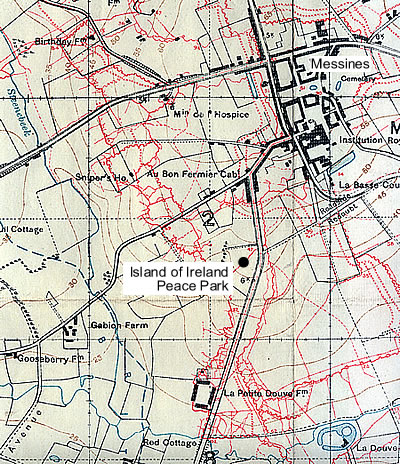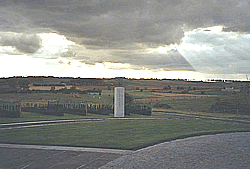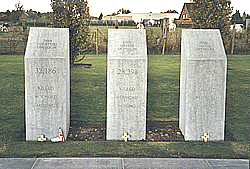Island of Ireland Peace Park

The memorial site is dedicated to the soldiers of Ireland, of all political and religious beliefs, who died, were wounded or missing in the Great War of 1914-1918. Irish men and women served with the Armies of Australia, Britain, Canada, New Zealand, South Africa and the United States.
The memorial site is also known as the “Irish Peace Park” or the “Irish Peace Tower”.
The tower was built as a symbol of reconciliation by An All-Ireland Journey of Reconciliation Trust and the support of the people of Messines (now called by its Flemish name Mesen). The design is that of a traditional Irish round tower dating back to the 8th century. It is 33.5 metres (110 feet) high. As part of the design the inside of the tower is lit up by the sun only on the 11th hour of the 11th day of the 11th month. This is the time at which the Armistice was declared and the guns fell silent on the Western Front after four years of fighting.
The Island of Ireland Peace Park was officially opened on 11 November 1998 by the President of Ireland Mary McAleese in the presence of HM Queen Elizabeth II and King Albert II of Belgium. Each year a commemorative Remembrance Day service is held at the Tower at 11.00 hours on 11 November.
Island of Ireland Peace Park at Messines

The Peace Park is situated south of the village of Messines / Mesen on the west side of the N365 from Ploegsteert to Messines / Mesen. British Army trench map 28 S.W.4 (Edition 3D) shows the German trenches and Front Line marked in red in position up to the time of the British attack on Messines on 7th June 1917. The position of the British Front Line trenches is indicated with a dashed blue line running to the east of Gabion Farm across the lower left hand corner of this map.
The site of the memorial is not the actual location where the two Irish divisions fought next to one another in the Battle of Messines Ridge in June 1917. Nevertheless, visitors can look to the west from the memorial across to the battle area of Wijtschaete / Wijtschate where they were in action. As can be seen from the trench map, the German Front Line up to June 1917 was just to the west of the memorial.

The photograph is taken at the Peace Park looking in a south-easterly direction across the British areas between Wulverghem on the right and the high ground of Hill 63 on the left. This illustrates the importance of holding a location on high ground where the German Army had excellent views of the British positions. The Germans captured this high ground in 1914 and held it for more than two years until the British exploded the mines on 7 June 1917 and followed with a highly successful advance to capture the whole area of the Messines Ridge.
The Peace Pledge
A bronze plaque near to the entrance of the Island of Ireland Peace Park is inscribed with a Peace Pledge:
“From the crest of this ridge, which was the scene of terrific carnage in the First World War on which we have built a peace park and Round Tower to commemorate the thousands of young men from all parts of Ireland who fought a common enemy, defended democracy and the rights of all nations, whose graves are in shockingly uncountable numbers and those who have no graves, we condemn war and the futility of war. We repudiate and denounce violence, aggression, intimidation, threats and unfriendly behaviour.
As Protestants and Catholics, we apologise for the terrible deeds we have done to each other and ask forgiveness. From this sacred shrine of remembrance, where soldiers of all nationalities, creeds and political allegiances were united in death, we appeal to all people in Ireland to help build a peaceful and tolerant society. Let us remember the solidarity and trust that developed between Protestant and Catholic Soldiers when they served together in these trenches.
As we jointly thank the armistice of 11 November 1918 – when the guns fell silent along this western front - we affirm that a fitting tribute to the principles for which men and women from the Island of Ireland died in both World Wars would be permanent peace.”
Commemorating the Irish at War

There are a number of small structures at the site located in the grounds of the park.
The photograph is taken looking in a south-easterly direction from the high ground of the Messines Ridge with the Tower behind the camera. This high ground was held by the Germans from October 1914 to 7 June 1917. The village of Messines is to the left of the photograph. The German defensive positions on this ridge prevented the British Army from seeing beyond the German Front Line except for observation carried out from the air.
The pillar on the right of the photograph is one of four pillars which name each of the provinces of Ireland: Leinster, Munster, Connaught and Ulster.
Three pillars in the memorial park commemorate the killed, wounded or missing of each of the three Irish divisions which fought with the British Army in WW1:
- 10th (Irish) Division - 9,363 casualties
- 16th (Irish) Division - 28,398 casualties
- 36th (Ulster) Division - 32,186 casualties
10th (Irish) Division

In June 1915 the 10th (Irish) Division prepared to move to the Mediterranean and on the 6/7 August 1915 the Division (less the 29th Brigade, which was operating with the Anzac Corps) landed at Suvla and assaulted the Turkish position.
For the remainder of the Great War the Division served in Gallipoli, Macedonia, Egypt, and Palestine.
16th (Irish) Division
In September 1916 the 16th (Irish) Division fought on the Somme battlefield at Guillemont and Ginchy.
In 1917 the Division moved to Ypres and at the Battle of Messines on 7 June it fought alongside the 36th (Ulster) Division. In August it again fought alongside the 36th (Ulster) Division at the battle of Langemarck. In March and April 1918 the Division was back on the Somme battlefield and took part in the battles of St. Quentin and Rosières. The Division returned to Flanders in October 1918 and fought with Fifth Army in the Final Advance.
36th (Ulster) Division
The 36th (Ulster) Division took part in the Battle of the Somme on 1 July 1916. In 1917 it fought at the Battle of Messines alongside the 16th (Irish) Division, and again alongside the same Irish Division at the battle of Langemarck in August 1917. Later the Division took part in the battle of Cambrai. Then in the following year 1918, it fought at St. Quentin, after which it moved back to Ypres fighting in the battles of Messines, Bailleul, Kemmel Ridge and finally the Advance in Flanders.
The Experience of War
Nine stone tablets are located in the grounds inscribed with quotations from poems, prose and letters from Irishmen at war.
One of the tablets contains a quotation by the poet Francis Ledwidge. He was killed in the Ypres Salient while serving with the Iniskilling Fusiliers on the first day of the Third Battle of Ypres (known as the Battle of Passchendaele), 31 July 1917:
“It is too late now to retrieve a fallen dream, too late to grieve a name unmade, but not too late to thank the Gods for what is great. A keen edged sword, a soldier’s heart is greater than a poet’s art. And greater than a poet’s fame a little grave that has no name.”
A memorial to Francis Ledwidge marks the place where he died near Boezinge (called Boesinghe in 1914-1918).
Another tablet contains a quote from the politician, lawyer, poet and essayist Tom Kettle. He was killed in action serving with the 9th Battalion Royal Dublin Fusiliers at Ginchy on 9 September 1916. He has no known grave and is commemorated on the Thiepval Memorial to the Missing (Pier and Face 16C) on the Somme battlefield.
“So here, while the mad guns curse overhead, and tired men sigh, with mud for couch and floor, know that we fools, now with the foolish dead, died not for Flag, nor King, nor Emperor, but for a dream born in a herdsman’s shed, and for the sacred scripture of the poor.”
Thiepval Memorial to the Missing
Roll of Honour
Inside the Tower there are record books with the names of the 49,400 known Irish who gave their lives in the First World War. About 300,000 Irishmen served in all armies in this war. These are copies of the original books held by the National War Memorial Gardens in Dublin, Ireland (see link in Useful Links below).
Location of the Island of Ireland Peace Park
The Peace Park is located on the west side of the N365 Ploegsteert-Mesen road, approximately 500 metres south from the centre of Mesen (known as Messines in 1914-1918).
Access to the Island of Ireland Peace Park
The memorial site is open to the public at all times.
Related Books




Related Topics
Cemeteries in the Ypres Salient Monuments and Memorials in the Ypres SalientUseful Links
Irish National War Memorial Gardens, Dublin, Ireland
Website: opwdublincommemorative.ie